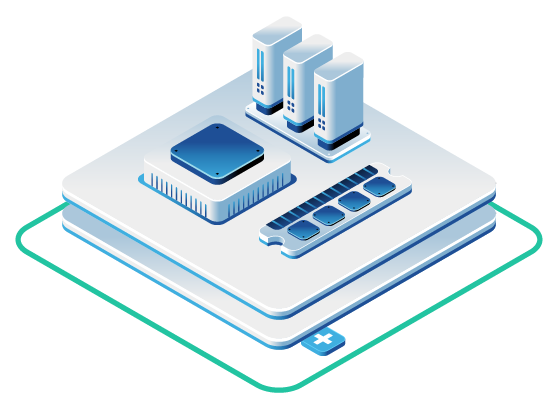In this article
- Understanding Storage Redundancy and Its Cost Impact
- The Problem with One-Size-Fits-All Redundancy
- How OpenMetal Enables Granular Storage Control
- Configuring Different Redundancy Levels for Different Environments
- Real-World Cost Savings from Reduced Redundancy
- Implementing Tiered Storage in Your Infrastructure
- Moving Forward with Cost-Aware Infrastructure
When you’re running multiple environments for development, staging, and production, every infrastructure decision multiplies across your entire pipeline. One decision that often gets overlooked is storage redundancy. While production workloads rightfully demand maximum fault tolerance, applying the same level of redundancy to development and staging environments can needlessly inflate your infrastructure costs by 30-50%.
We know redundancy matters. But does your staging environment really need the same level of data protection as the systems serving live customer traffic?
Understanding Storage Redundancy and Its Cost Impact
Storage redundancy is the practice of keeping multiple copies of your data across different physical drives or servers to protect against hardware failures. In distributed storage systems like Ceph, this redundancy comes in two primary forms: replication and erasure coding.
The default configuration for most cloud storage uses 3x replication, meaning every piece of data is stored three times across different physical locations. While this provides maximum fault tolerance, it creates 200% storage overhead. To store 1TB of actual data, you need 3TB of raw storage capacity.
Redundancy levels should match the reliability requirements of the specific use case. For production systems where downtime or data loss could impact customers or revenue, high redundancy levels are justified. But development and staging environments have fundamentally different risk profiles.
Staging environments serve as testing grounds that mirror production configurations, but they don’t carry the same business-critical requirements. If a staging server goes down during testing, it’s an inconvenience, not a customer-facing incident. This distinction creates an opportunity to reduce infrastructure costs without compromising your ability to thoroughly test code before production deployment.
The Problem with One-Size-Fits-All Redundancy
Most hyperscale cloud providers lock you into fixed storage configurations. When you provision storage on AWS, Azure, or Google Cloud, you’re working with predefined service tiers that apply the same redundancy levels regardless of whether you’re running development experiments or serving production traffic.
This approach makes sense from the provider’s perspective as it simplifies their infrastructure management. But it creates inefficiencies for customers who understand that non-production environments don’t require production-grade durability.
Organizations frequently overprovision their non-production infrastructure because they lack the ability to differentiate storage requirements by environment type. This overprovisioning extends beyond just storage. It affects compute, networking, and backup configurations across the entire development pipeline.
The underlying issue is control. Public cloud platforms abstract away the storage layer, which brings convenience but removes your ability to tune redundancy parameters. You’re paying for storage configurations designed for worst-case scenarios across all your workloads.
How OpenMetal Supports Granular Storage Control
 OpenMetal takes a fundamentally different approach by giving you direct access to the underlying Ceph distributed storage cluster. Because OpenMetal’s private cloud infrastructure runs on bare metal servers rather than nested virtualization, you get full root access to configure storage redundancy at the pool level.
OpenMetal takes a fundamentally different approach by giving you direct access to the underlying Ceph distributed storage cluster. Because OpenMetal’s private cloud infrastructure runs on bare metal servers rather than nested virtualization, you get full root access to configure storage redundancy at the pool level.
This architectural difference is huge. In Ceph, storage pools are logical containers that group data with specific redundancy and performance characteristics. You can create multiple pools with different configurations and present them through OpenStack as distinct storage tiers.
For a typical configuration, you might maintain replica 3 for production workloads requiring maximum reliability. This gives you the ability to tolerate two simultaneous disk failures without data loss. Meanwhile, you can configure development and staging environments with replica 2, which tolerates one disk failure while reducing storage overhead to 100%.
The beauty of this approach is that both pools exist simultaneously on the same physical hardware. OpenStack Cinder volume types map to different Ceph pools, allowing developers to select the appropriate storage tier when provisioning volumes. A production database might use the high-redundancy pool, while a staging database for the same application uses the lower-redundancy pool.
Erasure coding provides another option for balancing redundancy and efficiency. A 4+2 erasure coding profile spreads data across 6 chunks where any 4 chunks can reconstruct the complete data set, providing 67% storage efficiency while tolerating two failures. An 8+3 profile achieves 73% efficiency with three-failure tolerance. These profiles can cut raw storage requirements roughly in half compared to standard 3x replication while maintaining comparable fault tolerance for less critical workloads.
Because OpenMetal provides root access to the Ceph cluster, you implement these configurations directly through Ceph Ansible playbooks or command-line tools. There’s no need to submit support tickets or wait for provider approval since you control the infrastructure.
Configuring Different Redundancy Levels for Different Environments
The practical implementation of tiered storage starts with understanding your environment hierarchy. Development environments typically have the lowest durability requirements since they’re used for active coding and experimentation. Staging environments need to mirror production configurations for accurate testing, but don’t carry the same business continuity requirements. Production environments demand maximum protection.
Based on this hierarchy, a typical OpenMetal configuration might look like:
Production Storage Pool:
- Configuration: Replica 3 or 4+2 erasure coding
- Use case: Live customer data, production databases, critical applications
- Failure tolerance: 2 simultaneous failures
- Storage efficiency: 33% (replica 3) or 67% (4+2 EC)
Staging Storage Pool:
- Configuration: Replica 2 or simpler erasure coding
- Use case: Pre-production testing, QA validation, integration testing
- Failure tolerance: 1 failure
- Storage efficiency: 50% (replica 2)
Development Storage Pool:
- Configuration: Replica 2
- Use case: Active development, feature branches, experimental workloads
- Failure tolerance: 1 failure
- Storage efficiency: 50%
The implementation process involves creating Ceph pools with specific replication or erasure coding parameters, then mapping those pools to OpenStack Cinder volume types. When provisioning storage through OpenStack, developers simply select the appropriate volume type for their workload.
This approach aligns with cloud cost optimization best practices that emphasize matching resource specifications to actual requirements rather than over-provisioning across the board.
Real-World Cost Savings from Reduced Redundancy
The financial impact of tuned redundancy becomes clear when you calculate the hardware requirements for different configurations. Because OpenMetal uses fixed monthly pricing based on physical server resources rather than virtualized capacity, reducing storage redundancy directly translates to fewer physical drives and servers needed.
Consider a scenario where your staging environment requires 10TB of usable storage capacity:
With replica 3:
- Raw storage needed: 30TB
- Storage overhead: 200%
With replica 2:
- Raw storage needed: 20TB
- Storage overhead: 100%
- Hardware reduction: 33% fewer drives/servers
With 4+2 erasure coding:
- Raw storage needed: 15TB
- Storage overhead: 50%
- Hardware reduction: 50% fewer drives/servers compared to replica 3
For organizations running substantial development and staging infrastructure, these savings compound quickly. A medium-sized engineering team might maintain 50-100TB of staging storage. Switching from replica 3 to replica 2 could eliminate the need for an entire storage server, while erasure coding could reduce the footprint by half.
This differs fundamentally from public cloud pricing models where you pay per GB regardless of the underlying redundancy. The virtualized nature of public cloud storage means you never see (or benefit from) the actual hardware allocation. With bare-metal-backed infrastructure, you directly control how many physical resources you’re consuming.
The predictability of this cost model is particularly valuable for budget planning. When you reduce redundancy in staging, you immediately see the hardware cost reduction in your monthly invoice. There are no hidden charges, no unexpected egress fees, and no surprises from services you didn’t realize were consuming resources.
Beyond direct hardware costs, reduced redundancy also means fewer drives to maintain, less power consumption, and simpler failure recovery procedures for non-production environments.
Implementing Tiered Storage in Your Infrastructure
Moving to a tiered storage model requires both technical implementation and organizational alignment. The technical pieces are straightforward with root access to Ceph, but the organizational aspects deserve equal attention.
Start by auditing your current environment storage allocations. Document which environments exist, how much storage each consumes, and what the actual durability requirements are for each. This audit often reveals that development and staging environments have accumulated substantial storage that would benefit from lower redundancy.
Next, establish clear policies about which workloads belong in which storage tier. Production customer data always gets maximum redundancy. But what about internal analytics databases that aggregate production data for reporting? What about staging environments for internal tools versus customer-facing applications? These decisions should reflect actual business risk, not just default to maximum protection for everything.
Communication is particularly important when creating a DevOps culture around infrastructure efficiency. Engineers need to understand that lower redundancy in staging doesn’t mean accepting data loss, it means accepting an appropriate level of risk for workloads that can be rebuilt or restored from other sources.
The technical implementation involves:
- Creating new Ceph storage pools with appropriate redundancy configurations
- Defining OpenStack Cinder volume types that map to these pools
- Documenting which volume types should be used for which environment types
- Migrating existing volumes to appropriate tiers during maintenance windows
- Updating Infrastructure as Code templates to provision new volumes with correct storage tiers
For organizations working with CI/CD pipelines, automated provisioning should default to the appropriate storage tier based on the environment being provisioned. Your automation shouldn’t require developers to remember which storage tier to choose. It should make the right choice automatically based on environment tags or naming conventions.
Testing is particularly important during the migration process. While replica 2 provides adequate protection for staging workloads under normal circumstances, you should verify your backup and disaster recovery procedures work correctly with the new storage tiers. Run failure simulation tests to confirm that single-disk failures in staging pools don’t cause unexpected issues.
Remember that tiered storage is part of a broader cloud efficiency strategy. Combining reduced redundancy with other optimization techniques like automated resource scheduling and proper capacity planning compounds your cost savings across the entire infrastructure stack.
Moving Forward with Cost-Aware Infrastructure
The shift toward bare metal private clouds with full root access represents a change in how DevOps teams approach infrastructure management. Rather than accepting the constraints of hyperscale providers, you gain the ability to tune every aspect of your infrastructure to match actual requirements.
Storage redundancy is just one example of this control, but it’s an impactful one because storage costs affect every workload in your environment. By recognizing that not all environments carry the same business risk, you can allocate resources more efficiently without compromising reliability where it matters.
The organizations seeing the greatest success with this approach treat infrastructure as a product that evolves based on usage patterns and business needs. They instrument their environments to understand actual storage consumption patterns, regularly review redundancy configurations, and adjust as requirements change.
For teams managing substantial development and staging infrastructure, the path forward is clear: audit your current redundancy configurations, identify opportunities to reduce overhead in non-production environments, and implement tiered storage pools that match protection levels to actual requirements. The hardware cost savings are immediate, predictable, and compound over time as your infrastructure grows.
Your staging environment doesn’t need to be as bulletproof as production. By recognizing this distinction and configuring your infrastructure accordingly, you’ll free up budget that can be reinvested in areas that directly impact your ability to deliver value, whether that’s additional development resources, better monitoring tools, or expanding your production capacity.
Schedule a Consultation
Get a deeper assessment and discuss your unique requirements.
Read More on the OpenMetal Blog


































